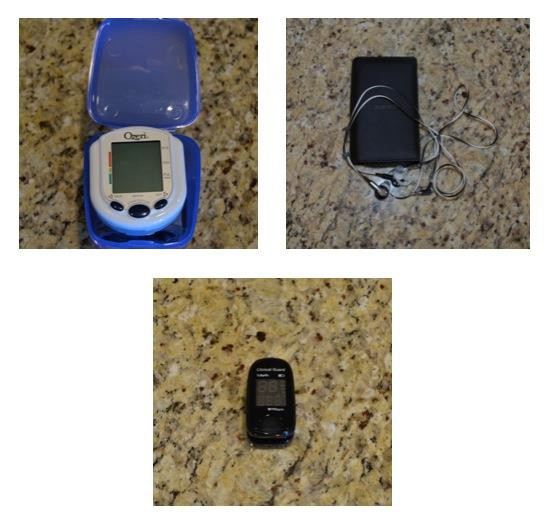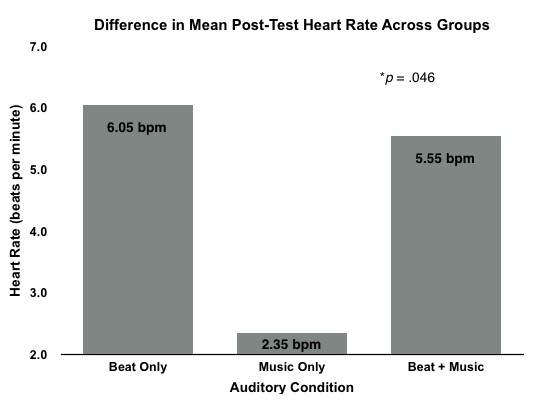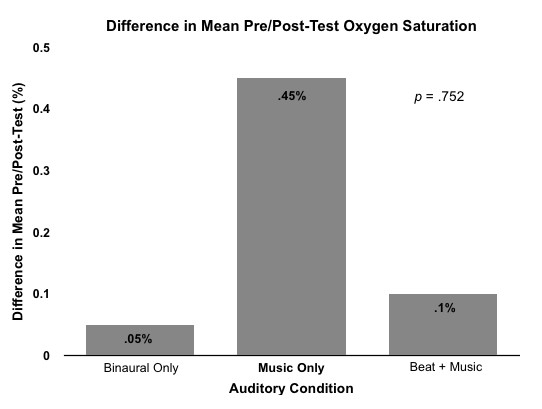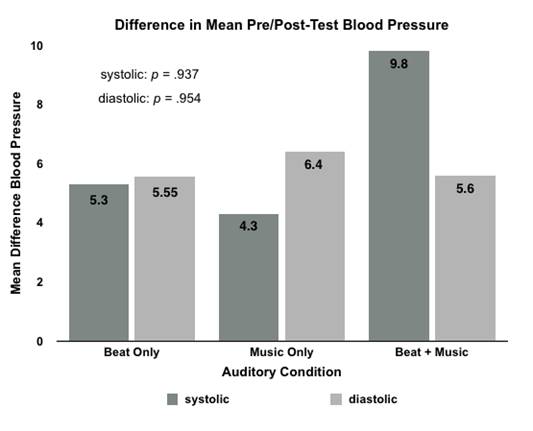Physiological Effects of Binaural Beats and Meditative Musical Stimulation
Elizabeth M. Hill and Christina M. Frederick
Sierra Nevada College
Keywords: Binaural beats, meditation, meditative, music, physiological effects, sampling
Abstract
The current study examined physiological effects of meditation music and binaural beats on humans, solo and in combination. A binaural beat is the presence of two separate auditory tones with equal amplitude and slightly differing frequencies (Goodin et al., 2012). Meditation music is often used with binaural beats to calm individuals (Chan et al., 2008). There is reason to believe binaural beats and meditative music impact human vital signs (Wahbeh et al., 2012). Heart rate, blood pressure, and oxygen saturation were recorded from 60 participants, tested individually, and randomly assigned to one of three listening groups: Beat + Music, Music Only, or Beat Only. Participants experienced their assigned auditory stimulation through headphones for 6 min. Physiological responses were recorded before and during auditory stimulation. A one- way ANOVA showed a significant difference in mean heart rate between listening groups (p = .046). Due to sample size limitations, a subsequent Tukey test (Abdi & Williams, 2010) could not identify the location of the significant difference. The largest difference in averages (at 9.05 bpm) existed between Beat Only and Music Only groups, therefore, indicating this as the location of the significant difference. No significant difference was found between listening groups in blood pressure (systolic: p = .937; diastolic: p = .954) or oxygen saturation (p = .752). It is recommended future studies in this domain incorporate larger sample sizes to ensure statistical sensitivity.
The Physiological Effects of Binaural Beats and Meditative Musical Stimulation
Heinrich Wilhelm Dove is credited with discovering binaural beats in 1839 and the topic has been scarcely studied since that time (Wahbeh, Calabrese, Zwickey, & Zajdel, 2007). A binaural beat is the presence of two separate auditory tones with equal amplitudes and slightly differing frequencies. Each differing frequency, measured in Hertz (Hz), is presented to the listener’s ears and the brain interprets both sounds as one, thus, creating the perceived beat (Goodin, Ciorciari, Baker, Carry, Harper, & Kaufman, 2012). For example, if a frequency of 400 Hz is heard in one ear and 420 Hz is heard in the other, the two sounds have a binaural beat of 20Hz. The corresponding 20 Hz produces a third beat; the binaural beat. It is interpreted by the brain as an additional note or tone in the set. The beat, itself, is illusory (Goodin et al., 2012). The three stipulations concerning a binaural beat being heard are that both frequencies must be under 1000 Hz, no more than 30 Hz apart, and the listener must hear the beats through headphones or specifically placed speakers in a room, though evidence suggests that headphones produce more satisfactory results (Lavallee, Koren, & Persinger, 2011). Binaural beats are heard by the human ear at various wavelengths and include delta, theta, gamma, epsilon, and alpha waves (Awada, 2012). In addition, various studies (Lane, Kasian, Owens, & Marsh, 1998; Wahbeh et al., 2007) performed tests to measure the effects of binaural beats on motor function and reaction time.
Lane et al. (1998) presented beta, theta, and delta binaural beats between 16 Hz and 24Hz or 1.5 Hz and 4 Hz, in the background, to participants for approximately 30 min. A single tone in the foreground, outside of the binaural beat frequency range, was also presented with the beat (Lane et al., 1998). During auditory stimulation, participants completed a variety of alertness tests, such as pressing a key on a computer when a particular stimulus was presented (Lane et al., 1998). Lane et al. (1998) hypothesized a beta frequency would increase the number of correct responses, relative to theta and delta frequencies, which they hypothesized would have no effect. Results indicated, of 180 possible targets, participants exposed to beta frequencies scored significantly higher on the number of correct target hits, with fewer incorrect hits, while those exposed to theta and delta frequencies identified significantly more incorrect targets than their beta counterparts (Lane et al., 1998). Lane et al. (1998) points out that beta binaural beats can improve motor skill test scores, while theta and delta frequencies result in reduced motor function and increased reaction time. The current study draws on evidence from Lane et al. (1998) to appropriately select frequency ranges and types. A 7 Hz theta beat was used in the current study.
Goodin et al. (2012) proposed the Frequency Follow Response (FFR) presented multiple physiological and psychological occurrences in which the body’s neural responses could be altered through external stimuli, therefore, allowing the brain the synchronize its electrical frequency with what is heard. The applications of binaural beats and their impact on electrical brainwaves in humans have been incorporated into meditation style music while practicing yoga, tai chi, and controlled breathing exercises (Lavallee et al., 2011).
FFR suggests the brain can alter its state of consciousness through the stimulation of external frequencies, without prior practice or training (Goodin et al., 2012). Lane et al. (1998) suggests hearing delta and theta frequency ranges can assist in improved sleep patterns and a heightened sense of creativity, however, no studies have been published relating solely to the basic physiological responses with the presence of binaural beats. These include baseline heart rate, blood pressure, and oxygen saturation relative to the absence or presence of a binaural beat, and changes seen to the aforementioned functions during binaural beat stimulation and after
stimulation has occurred. To the contrary, many studies including Harmat, Takacs, and Bodizs (2008) and Thoma, La Marca, Brönnimann, Finkel, Ehlert, and Nater (2013) have studied the effects of calming, meditation style music on physiological responses.
Harmat et al. (2008) studied the effects of playing classical music, an audio book, or doing nothing at all, for 45 min before bedtime, every night for three consecutive weeks, on anxiety, depression, blood pressure, heart rate, and several other factors involving the sympathetic nervous system. Participants were given sleep, anxiety, and depression tests or questionnaires before, once per week, and after the three week testing period had concluded (Harmat et al., 2008). Results indicated global sleep quality significantly improved in participants listening to classical music band lowered heart rate and blood pressure (Harmat et
al., 2008). This study provides evidence that calming music reduces anxiety, blood pressure, and heart rate. The physiological responses this study displayed are an important factor in the current study.
A second study conducted by Thoma et al. (2013), however, refutes the hypothesis that music impacts physiological responses. Thoma et al. (2013) studied the effects of listening to music prior to a stressor task. Two groups, one listening to calming music and one listening to the sound of rain, listened to their designated auditory tracks and then performed a public speaking or math task in front of a group (Thoma et al., 2013). Results showed no significant difference in physiological responses, including heart rate, blood pressure, and respiratory rate, for either group (Thoma et al., 2013). The stress hormone cortisol was, however, significantly lowered for the music group prior to task performance and it returned to baseline much faster after the stressor task had been completed (Thoma et al., 2013). This suggests that music has a perceived calming effect on individuals, but does not actually illicit physiological changes other than in cortisol levels. The current study aims to examine the physiological effects of meditation style music on individuals, with the absence or presence of binaural beats. Meditation style music is considered because of the beneficial effects of calming music in previous studies and the study of brain frequency levels during practiced meditation.
Chan, Han, and Cheung (2008) studied the Mindfulness-Based Triarchic Body-Pathway Relaxation Technique (TBRT) to determine the brain’s frequencies and activity during a basic meditation exercise. Meditation is strongly associated with altered and/or increased activation of the autonomic and endocrine systems (Chan et al., 2008). Chan et al. (2008) focused explicitly on theta power, meditation music, and the practice of meditation itself. Results of this study indicate significantly higher theta power for the participants practicing TBRT and listening to calming meditation style music and, in addition, the group practicing only TBRT showed significantly higher theta power in the frontal lobe of the brain (Chan et al., 2008). This study provided further evidence that theta frequencies increased relaxation and, therefore, theta frequencies were employed in the current study.
New age healing techniques are beginning to incorporate binaural beat technology and meditation style music in therapy sessions and from a personal standpoint, specifically with meditation routines and practices (Awada, 2012). Lavallee et al. (2011) used facilitative (7 Hz) and hindering (15 Hz) binaural beats during a meditation session to determine the effects of the beats on the meditative process. Depending on the frequency of the binaural beat presented, they exhibit mild sedative effects as well. Therefore, a 15 Hz beat was used to prevent meditators from reaching their full relaxed state, while the 7 Hz beat was used to encourage further relaxation (Lavallee et al., 2011). Two groups, experienced and novice meditators, listened to the hindering and facilitative beats. Results indicated a much higher theta power for experienced meditators listening to the 7 Hz facilitative binaural beat (Lavallee et al., 2011). Novice meditators (i.e., less than 10 months experience) exhibited elevated theta power, but did not show a significant difference between the hindering and facilitative groups (Lavallee et al., 2011). The current study employed a 7 Hz theta binaural beat due to evidence exhibited in the aforementioned study regarding its calming effects. While empirical research regarding binaural beats and physiological responses is limited, physiological responses to calming music and its impact on perceived stress, relaxation, anxiety, and anger has been studied (e.g., Chan et al., 2008; Harmat et al., 2008; Labbé Schmidt, Babin, & Parr, 2007; Thoma et al., 2013; Nilsson, 2009).
The current study examined physiological responses in the presence or absence of binaural beats and in the absence or presence of meditation style music. Vital signs including heart rate, oxygen saturation, and blood pressure were tested. The purpose of the current study was to determine whether binaural beats or meditation style music could elicit physiological responses. Several hypotheses were at play. Specifically, it was hypothesized that auditory presentation of a theta (7-9 Hz) binaural beat, by itself, would (1) lower heart rate, relative to baseline, (2) maintain oxygen saturation between 90%-100% (normal) and (3) reduce blood pressure relative to participant baseline. Additionally, it was hypothesized meditation music, by itself, would (1) lower heart rate relative to baseline, (2) maintain oxygen saturation in the normal range, and (3) reduce blood pressure. The current study was performed under the assumption that, according to previous studies, the human brain is impacted by the presence of binaural beats and/or meditation style music. If the human brain is impacted by the addition of binaural beats or meditation music, and the brain controls all bodily functions, these beats and calming music should impact basic vital signs, either together, or independently.
Method
The current study aimed to test participants on multiple levels. Blood pressure, oxygen saturation, and heart rate were measured while participants listened to one of three auditory tracks; a 7 Hz theta binaural beat, meditation music, or a combination of the two.
Participants
Sixty adults, aged 18-35 (mean age = 22.3), were gathered via convenience sampling to participate in the current study. Twenty participants were assigned to each group. Participants were informed, via informed consent, they would be participating in a study involving the measurement of a subset of their vital signs in the presence of an auditory track over the course of 10-15 min. Participants were tested individually to minimize distraction and personal information data was kept confidential. Participants were randomly assigned to one of three groups (Music Only, Beat Only, or Beat + Music) via computer randomization software. The Music Only group contained 13 men and 7 women (mean age = 23.1), the Beat Only group contained 11 men and 9 women (mean age = 22.55), and the Beat + Music group was comprised of 7 men and 13 women (mean age = 21.35). Participants received research credit for their time.
Materials
Blood pressure was measured with an Ozeri CardioTech Pro Series Blood Pressure Cuff, applied to the wrist (see Appendix A, Figure 1). Oxygen saturation and heart rate were measured with an OctiveTech OT99 Finger Pulse Oximeter (see Appendix A, Figure 1), produced by Clinical Guard, and applied to the left index finger. All instruments were non-invasive and sterilized with medical alcohol prep pads before and after each use. One set of BOSE IE2 in-ear headphones (see Appendix A, Figure 1) was used and thoroughly sterilized before and after each use. Audio selection included “7 Hz Theta Beat Only” for Beat Only group (Full Length Binaurals, 2011), “Relaxing Sounds - Zen - Chinese Bamboo Flute with Nature Sounds” for the Music Only group (Full Length Binaurals, 2011), and “Binaural Beat with Music” for the Beat + Music group. The Beat + Music track was created via Apple GarageBand 2009. Audio tracks were played via Apple iTunes on a 2011 Apple MacBook Pro.
Procedure
The current study was a single-blind experiment. Participants were not informed of their assigned group to minimize measure reactivity and potential placebo effects. Each data collection session took approximately 10-15 min, from beginning to completion. Participants
were tested individually to reduce external distractors. After an initial briefing and application of measurement devices, participants were asked to remain seated and still for 2 min, upon which time their pre-test vital signs were taken to establish baseline. Participants, then, listened to their assigned audio track. At the 6 min mark, vital signs were re-measured while participants continued listening with their eyes closed. After 8 min of auditory stimulation, the track was stopped and post-test vitals were recorded. The participant removed all devices and was provided a debrief regarding the purpose of the study.
Results
Individual data were sorted and averaged across auditory condition and vital sign measurement. Data were determined to be homogeneous and were also found to be normally distributed, thus, vital sign measurements were submitted to a one-way ANOVA. Having adopted a significance level of .05, the one-way ANOVA for heart rate showed a significant difference (p = .046) in means across all three groups. Since the one-way ANOVA indicated at least one measure was significantly different from the others, the data were submitted to a subsequent Tukey Test (Abdi & Williams, 2010) to determine where the difference existed.
Unfortunately, due to sample size limitations and the statistical sensitivity of the Tukey Test, this analysis was not able to identify which group was significantly different from the others. The magnitude of difference between auditory condition averages in heart rate suggests the significant difference may lie between the Beat Only and Music Only groups (see Appendix B, Figure 2). No significant difference in group means was found in oxygen saturation (p = .752; see Appendix C, Figure 3) or blood pressure (systolic: p = .937; diastolic: p = .954) for any of the three groups (see Appendix D, Figure 4).
Discussion
It was originally hypothesized that the presence of binaural beats and/or meditation music would reduce heart rate and blood pressure while maintaining oxygen saturation at a normal level. While there is an indication of change in heart rate between Beat Only and Music only conditions, it is advised further research verify this finding with a larger sample. Oxygen levels were maintained across the three auditory conditions.
Goodin et al. (2012), Lavallee et al. (2011), and Wahbeh et al. (2007) reported no physiological changes in the presence of binaural beat stimulation. The current study does not align with previous research regarding heart rate, as a significant difference in mean heart rate across groups was indicated, however, previous studies (Goodin et al., 2007) measuring blood pressure during both binaural beat and calming musical stimulation do match the results of the current study as no significant difference was found in these areas. No empirical research was found to have measured oxygen saturation, making the current study a novel contribution to the field. Methodological concerns materialized after completion of the current study. No screening was conducted to assess participants’ quality of hearing. It was assumed participants did not have hearing deficits. It is suggested future studies administer a hearing test prior to any auditory testing. Also, to increase statistical sensitivity, it is recommended sample size be increased (Abdi & Williams, 2010). A method for ensuring sufficient sample size is to determine necessary sample size prior to any data collection based on a power analysis. It is also suggested future studies of this type employ a double-blind design.
The results of the current study will stimulate future research regarding binaural beats and meditation music practices as alternative health benefits. When studying binaural beats or meditation music for anxiety, physical injury, or specific mental disorders, heart rate should be a key focus due to the importance of physical calmness impacting mental calmness. Both beats and meditative music, solo and in combination, can be incorporated into one’s lifestyle to lower heart rate and further assist in alternative healing techniques.
References
Abdi, H., & Williams, L. J. (2010). Tukey’s honestly significant difference (hsd) test. Retrieved from http://www.utdallas.edu/~herve/abdi-HSD2010-pretty.pdf
Awada, M. (2012, April 3). Binaural beats: Medication on your iPod [Web log post]. Retrieved from http://www.astounde.com/binaural-beats-medication-on-your-ipod/
Chan, A. S., Han, Y. M. Y., & Cheung, M.-C. (2008). Electroencephalographic (EEG) measurements of mindfulness-based triarchic body-pathway relaxation technique: A pilot study. Applied Psychophysiological Biofeedback, 33, 39-47. doi: 10.1007/s10484-008-9050-5
Full Length Binaurals. (2011, March 2). Theta Binaural Beat (7Hz) ~ Pure [Video file]. Retrieved from http://www.youtube.com/watch?v=E5G6mLNfayA
Goldberg, S., Buhbut, E., Mimouni, F. B., Joseph, L., & Picard, E. (2012). Effect of moderate elevation above sea level on blood oxygen saturation in healthy young adults. Epub: US National Library of Medicine, 84(3), 207-211. doi: 10.1159/000336554
Goodin, P., Ciorciari, J., Baker, K., Carry, A.-M., Harper, M., & Kaufman, J. (2012). A high- density EEG investigation into steady state binaural beat stimulation. PLOS ONE, 7(4),
1-9. doi: 10.1371/s10484-007-9043-9
Harmat, L., Takács, J., & Bódizs, R. (2008). Music improves sleep quality in students. Journal of Advanced Nursing, 62(3), 327-335. doi: 10.1111/j.1365-2648.2008.04602.x
Labbé, E., Schmidt, N., Babin, J., & Parr, M. (2007). The effectiveness of different types of music. Applied Psychophysiology and Biofeedback, 32(3-4), 163-168.
Lane, J.D., Kasian, S.J., Owens, J.E., & Marsh, G.R. (1998). Binaural auditory beats affect vigilance performance and mood. Physiology & Behavior, 63(2), 249-252.
Lavallee, C. F., Koren, S. A., & Persinger, M. A. (2011). A quantitative electroencephalographic study of meditation and binaural beat entrainment. The Journal of Alternative and Complimentary Medicine, 17(4), 351-355.
doi: 10.1089/acm.2009.0691
Nilsson, U. (2009). The effect of music intervention in stress response to cardiac surgery in a randomized clinical trial. Heart & Lung, 38(3), 201-207.
Thoma, M. V., La Marca, R., Brönnimann, R., Finkel, L., Ehlert, U., & Nater, M. U. (2013). The effect of music on human stress response. PLOS ONE, 8(8), 1-13.
Wahbeh, H., Calabrese, C., Zwickey, H., & Zajdel, D. (2007). Binaural beat technology in humans: A pilot study to assess neuropsychologic, physiologic, and electroencephalographic effects. The Journal of Alternative and Complimentary Medicine, 13(7), 199-206. doi: 10.1089/acm.2006.6201
Appendix A

Figure 1. An Ozeri CardioTech Pro Series blood pressure cuff which was applied to the right wrist and raised to the participant’s heart (top left). A set of BOSE IE2 in-ear headphones are used to present auditory stimuli to each participant. This specific model was used to enhance sound dynamics and range (top right). An OctiveTech OT99 Finger Pulse Oximeter was used to measure participant heart rate and oxygen saturation. It was applied to the right index finger. Saturation was measured via infrared light transmission through the skin (bottom).
Appendix B

Figure 2. Difference in post-test mean heart rate for each auditory condition is shown. A difference of 3.7 beats per minute between Beat Only and Music Only group is, likely, where the significant difference was.
Appendix C

Figure 3. Difference in pre/post-test mean oxygen saturation is shown. No significant difference was found.
Appendix D

Figure 4. Difference in pre/post-test mean blood pressure is shown. No significant difference was found for either systolic or diastolic pressure.